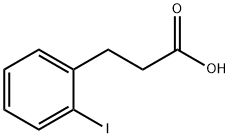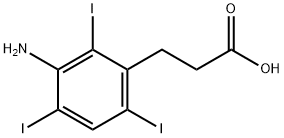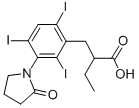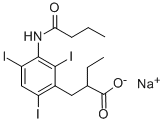2-[3-(butyrylamino)-2,4,6-triiodobenzyl]butyric acid
- CAS NO.:27293-82-9
- Empirical Formula: C15H18I3NO3
- Molecular Weight: 641.02
- MDL number: MFCD00867926
- EINECS: 2483898
- SAFETY DATA SHEET (SDS)
- Update Date: 2023-05-04 17:34:36
![2-[3-(butyrylamino)-2,4,6-triiodobenzyl]butyric acid Structural](https://img.chemicalbook.in/CAS/GIF/27293-82-9.gif)
What is 2-[3-(butyrylamino)-2,4,6-triiodobenzyl]butyric acid?
Absorption
This triiodide is well absorbed by the small intestine and it is excreted in the bile within 2 h after oral administration . It has been found to be readily absorbed and show maximal radiographic definition at 10-12 h post ingestion, but this can occur as early as 4-6h .
Toxicity
LD50 i.v. in mice: 720 mg/kg .
Since the introduction of iopanoic acid (Telepaque) in 1951, widespread clinical application has demonstrated that this medium represents an ideal cholecystographic agent.1 Iopanoic acid [β-(3-amino-2, 4, 6-triiodophenyl)-α-ethylpropionic acid] contains 66.68% iodine. Maximum concentration in the gallbladder occurs at from 10 to 12 hours. Iopanoic acid is excreted primarily through the intestinal tract. Its elimination is rapid and complete within 48 hours. Toxic reactions to this agent are rare, and side-effects rarely occur .
Although the foregoing oral cholecystographic agents are relatively non-toxic substances, adverse reactions such as minor gastrointestinal disturbances or allergic reactions are occasionally observed. Therefore, it is highly desirable, in order to minimize the occurrence of these undesirable side-effects, to use as low a dose as possible and maintain the blood plasma iodine concentration at the lowest possible level without sacrificing adequate imaging of the gallbladder .
A study was done on this agent in basic form and slow-release form . The acute oral toxicity in mice of the basic formulation was determined, and a 7-day LD50 value of 5042 (3623-6596) mg/kg in terms of sodium tyropanoate was obtained. This compared to a Ld50 value of 3158 (1302-3900) for commercial sodium tyropanoate capsule mix (uncoated). The sustained release preparation was thus statistically significantly less toxic than the immediate-release material .
The Uses of 2-[3-(butyrylamino)-2,4,6-triiodobenzyl]butyric acid
Tyropanoic Acid acts as a cholecystographic agent that interferes with the binding of thyroid hormones.
Background
Tyropanoic acid is a radiocontrast agent used in cholecystography, the X-ray diagnosis of gallstones under the trade names include Bilopaque, Lumopaque, Tyropaque, and Bilopac. The molecule contains three heavy iodine atoms which obstruct X-rays in the same way as the calcium in bones, which results in a visible image .
Indications
For use in cholecystography (X-ray diagnosis/imaging of gallstones).
Definition
ChEBI: Tyropanoate is a monocarboxylic acid and a member of benzenes.
brand name
Bilopaque (GE Healthcare).
Pharmacokinetics
Tyropanoate sodium, also known as sodium tyropanoate, is a radiocontrast agent used in cholecystography (X-ray imagining and diagnosis of gallstones). This molecule contains three heavy iodine atoms which obstruct X-rays to produce a visible image. After injection, it is rapidly excreted into the bile .
Metabolism
Conjugated with glucuronic acid in the liver .
Properties of 2-[3-(butyrylamino)-2,4,6-triiodobenzyl]butyric acid
| Melting point: | 172-185.5 °C |
| Boiling point: | 608.7±55.0 °C(Predicted) |
| Density | 2.143±0.06 g/cm3(Predicted) |
| pka | 4.53±0.19(Predicted) |
Safety information for 2-[3-(butyrylamino)-2,4,6-triiodobenzyl]butyric acid
Computed Descriptors for 2-[3-(butyrylamino)-2,4,6-triiodobenzyl]butyric acid
New Products
Tert-butyl bis(2-chloroethyl)carbamate (S)-3-Aminobutanenitrile hydrochloride N-Boc-D-alaninol N-BOC-D/L-ALANINOL N-octanoyl benzotriazole 4-Hydrazinobenzoic acid 3,4-Dibenzyloxybenzaldehyde Electrolytic Iron Powder 1,1’-CARBONYLDIIMIDAZOLE R-2-BENZYLOXY PROPIONIC ACID 4-HYDROXY BENZYL ALCOHOL 1,1’-CARBONYLDI (1,2-4 TRIAZOLE) S-2-CHLORO PROPIONIC ACID (2-Hydroxyphenyl)acetonitrile 4-Bromopyrazole 5-BROMO-2CYANO PYRIDINE 5,6-Dimethoxyindanone 5-broMo-2-chloro-N-cyclopentylpyriMidin-4-aMine 3-(Hydroxymethyl)benzoate N-Boc-2-chloroethylamine 1-Bromo-2-methoxy-3-nitrobenzene N-Methyl-3-cyclopenten-1-amine 2-Bromo-3-hydroxybenzaldehyde 1H-indazole-5-carboxamideRelated products of tetrahydrofuran
![2-[3-(butyrylamino)-2,4,6-triiodobenzyl]butyric acid](https://img.chemicalbook.in/CAS/GIF/27293-82-9.gif)







You may like
-
 7441-43-2 98%View Details
7441-43-2 98%View Details
7441-43-2 -
 1260741-78-3 6-Bromo-3-iodo-1-methyl-1H-indazole 98%View Details
1260741-78-3 6-Bromo-3-iodo-1-methyl-1H-indazole 98%View Details
1260741-78-3 -
 (3-Benzyloxypropyl)triphenyl phosphonium 98%View Details
(3-Benzyloxypropyl)triphenyl phosphonium 98%View Details
54314-85-1 -
 4-bromo-3,5-dimethylbenzenesulfonyl chloride 1581266-79-6 98%View Details
4-bromo-3,5-dimethylbenzenesulfonyl chloride 1581266-79-6 98%View Details
1581266-79-6 -
 2490430-37-8 98%View Details
2490430-37-8 98%View Details
2490430-37-8 -
 N-(5-Amino-2-methylphenyl)acetamide 5434-30-0 98%View Details
N-(5-Amino-2-methylphenyl)acetamide 5434-30-0 98%View Details
5434-30-0 -
 124371-59-1 98%View Details
124371-59-1 98%View Details
124371-59-1 -
 53857-52-2 98%View Details
53857-52-2 98%View Details
53857-52-2